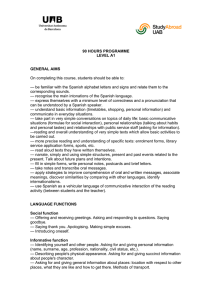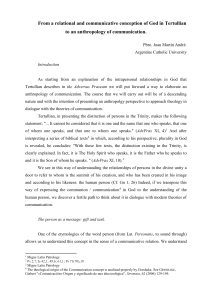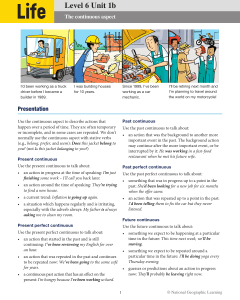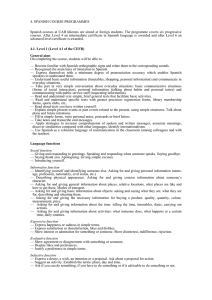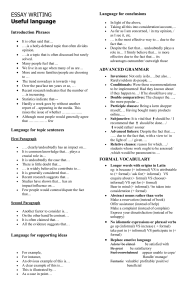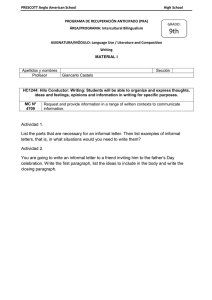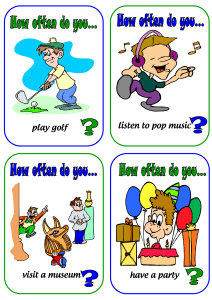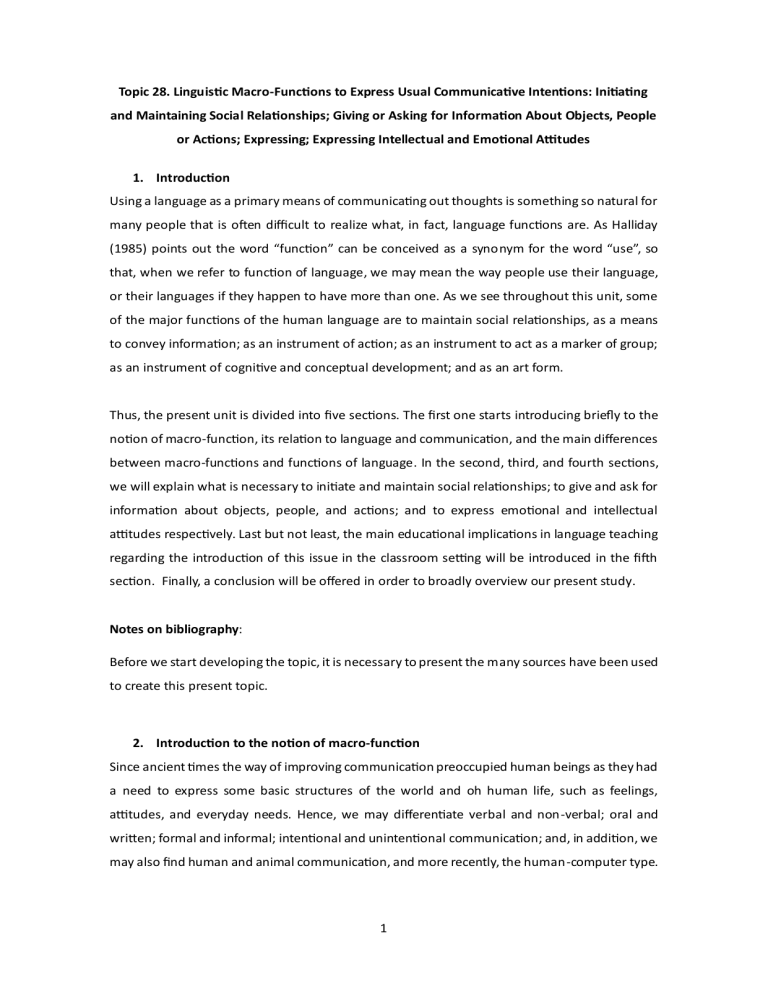
Topic 28. Linguistic Macro-Functions to Express Usual Communicative Intentions: Initiating and Maintaining Social Relationships; Giving or Asking for Information About Objects, People or Actions; Expressing; Expressing Intellectual and Emotional Attitudes 1. Introduction Using a language as a primary means of communicating out thoughts is something so natural for many people that is often difficult to realize what, in fact, language functions are. As Halliday (1985) points out the word “function” can be conceived as a synonym for the word “use”, so that, when we refer to function of language, we may mean the way people use their language, or their languages if they happen to have more than one. As we see throughout this unit, some of the major functions of the human language are to maintain social relationships, as a means to convey information; as an instrument of action; as an instrument to act as a marker of group; as an instrument of cognitive and conceptual development; and as an art form. Thus, the present unit is divided into five sections. The first one starts introducing briefly to the notion of macro-function, its relation to language and communication, and the main differences between macro-functions and functions of language. In the second, third, and fourth sections, we will explain what is necessary to initiate and maintain social relationships; to give and ask for information about objects, people, and actions; and to express emotional and intellectual attitudes respectively. Last but not least, the main educational implications in language teaching regarding the introduction of this issue in the classroom setting will be introduced in the fifth section. Finally, a conclusion will be offered in order to broadly overview our present study. Notes on bibliography: Before we start developing the topic, it is necessary to present the many sources have been used to create this present topic. 2. Introduction to the notion of macro-function Since ancient times the way of improving communication preoccupied human beings as they had a need to express some basic structures of the world and oh human life, such as feelings, attitudes, and everyday needs. Hence, we may differentiate verbal and non-verbal; oral and written; formal and informal; intentional and unintentional communication; and, in addition, we may also find human and animal communication, and more recently, the human-computer type. 1 So, communication processes prove quite complex since there is more to communication that just one person speaking and another one listening. For most of its history, the concept of communication has always been approached from different disciplines such as anthropology, psychology, or sociology among others, in order to provide an appropriate definition for the term. Still, communication is traditionally understood as “the exchange and negotiation of information between, at least, two individuals through the use of verbal and non-verbal symbols, oral, and written, and production and comprehension processes” (Halliday, 1973). With respect to the concept of “language”, Halliday (1973) defined it as “an instrument of social interaction with a clear communicative purpose”. For Malinowsky (1948), a relevant figure in anthropology, language had only two main purposes: pragmatic and ritual. The former refers to the practical use of language, either active, by means of speech, or narrative, by means of written texts. The latter is concerned with the use of language associated to ceremonies, and also referred to as magic. Following Crystal (1985), one of the main characteristics of language is that it is an essential tool of communication. When the act of communication is verbal, the code is the language. Regarding the structured use of the auditory-vocal channel, it may result in speech, but also non-verbal communicative uses of the vocal tract are possible by means of para-language, such as whistling of musical effects. However, when we refer to non-verbal communication, visual and tactile modes are concerned. They may be used for a variety of linguistic purposes such as the use of sign languages. Thus, writing a letter, having a conversation, watching a play, or reading a magazine, among others, are instances of verbal communication by means of language. However, other means such as gestures, facial expressions, body language, touch and so on, are non-verbal, although they are also components of the communication process. Yet, it is within Jakobson’s model (1960), which deals with the characteristics of communication and, in particular, its elements, that we find one of the first references to macro-linguistic functions. According to Jakobson, this term was introduced to explain how language works in all acts of communication, be they written or oral. Jakobson defined six functions of language, thus referential, emotive, conative, phatic, meta-lingual, and poetic. For instance, any particular act of communication takes places in a situational context whereby the referential function refers to what it being spoken of and what is being referred to; the attitude of the addresser/encoder 2 is related to the emotive or expressive function through emphasis, intonation, loudness, or pace. The responder in the addressee/decoder is associated with the conative function. The poetic function focuses on message by means of associations (equivalence, similarity, and dissimilarity, synonyms, and antonyms); repetitions of sound values, stresses, accents; and the word and phrase boundaries and relationships. The metalinguistic function is related to the use of the same codes for the message to be understood. And, finally, the channel is associated to the phatic function, enabling both addresser and addressee to enter and stay in communication. Macro-functions are approached by Halliday following a sociological model, that is, the ways in which language is used for different purposes and in different situations. Halliday (1985) declared in his work An Introduction to Functional Grammar, that his functional grammar provides a description of how the structure of English relates to the variables of the social context in which the language is functioning in this way, it is uniquely productive as an educational resource for teaching. For Halliday, messages combine an organization of content according to the receptive needs of the speaker and listener, and the meaning they are expressing. Thus, for Halliday, the macro-functions are mainly three, the ideational, the interpersonal, and the textual. Later, he divided the ideational one into two others: the experiential, and the logical. These macro-functions stem from the interrelation between seven basic functions of language use which are used independently in children’s speech. Firstly, the instrumental to express desires and needs; the regulatory, where rules, instructions, orders, and suggestions are included; the interactional, where we may include patterns of greeting, leave-taking, thanking, good wishes, and excusing; the personal, which encourages students to talk about themselves and express their feelings; the heuristics, which focuses on asking questions; the imaginative, used for supposing, hypothesizing, and creating for the love of sound and image; and, finally, the representational, used for abstract explanations. Also, it is fundamental to establish the difference between language functions and macro functions by means of the notions of topics organized into communicative functions. For instance, language functions are related to the semantic notions of “introductions, giving personal opinion, asking for directions, apologizing, regretting, etc.” which may belong more naturally to one of the other topics being specifically defined (personal identification, jobs, free time, hobbies, education, health and welfare, visiting tourist places, weather, etc.) whereas macro-functions are described in terms of communicative inventions, that is, more pragmatically 3 relevant (describing actions; asking for an giving information; socializing; emotional relations, etc.). So the most usual macro-functions are initiating and maintaining social relationship (Halliday’s interactional); giving and asking for information about objects, people, and actions (Halliday’s ideational → experiential and logical); and to express emotional and intellectual attitudes (Halliday’s textual). Several classifications of linguistic functions have been attempted by different scholars through different disciplines. However, more recently, in 2001, the CEFR (Common European Framework of Reference for Languages) summarized a great deal of the theories of the functions of language and developed the concept of “functional competence”, within linguistic competence, referring to the user/learner’s ability to use language for the different functions needed. This component is concerned with the use of spoken discourse and written texts in communication for particular functional purposes, and a difference between micro-functions, macro-functional purposes, and a difference between micro-functions, macro-functions and interaction schemata is drawn. Hence, functional competence is not simply a matter of knowing particular functions (microfunctions) are expressed by which language form. Participants are engaged in an interaction, in which each initiative leads to a response and moves the interaction further on, according to its purpose, through a s succession of stages from opening exchanges to its final conclusion. Competent speakers have understanding of the process and skills in operating it. A macrofunction is characterized by its interactional structure. More complex situations may well have an internal structure involving sequences of macro-functions, which in many cases are ordered according to formal or informal patterns of social interaction (schemata). Thus, micro-functions are categories for the functional use of single (usually short) utterances, usually as turns in an interaction. For example, imparting and seeking factual information (identifying, reporting, correcting, asking, answering). Macro-functions are categories for the functional use of spoken discourse or written text consisting of a sequence of sentences. For example, description, narration, commentary, exposition, exegesis, explanation, demonstration, instruction, argumentation, persuasion). Interaction schemata is finally another element of the functional competence which refers to the knowledge of and ability to use the schemata (patterns of social interaction) which underlie communication, such as verbal exchange. At their 4 simplest, they form pairs such as question: answer, statement: agreement/disagreement, request/offer/apology: acceptance/non-acceptance, greeting/toast: response. 3. Initiating and maintaining social relationships Now we shall analyze the communicative intention of “initiating and maintaining social relationships” or, in other words, “socializing” through the phatic function, which is related to the channel in the communication process, enabling both addresser and addressee to enter and stay in communication. This macro-function will be analyzed in terms of form, function, and main uses, where we can establish a further classification of language functions. Let’s start with attracting attention, which is achieved by means of noun phrases, usually places at the beginning of a sentence, or uttered individually like “Excuse me”, “Hello”, “I say…”, “Waiter!”, “Look!”, “You see”. These nouns or noun phrases are usually pronounced with a rising intonation, often within the framework of an exclamatory syntactic structure. Semantically, a quick answer is expected. Then we have greeting people and respecting to its language function, semantically we may distinguish two types: • Greetings strangers and acquaintances by means of noun phrases like “Good morning/afternoon/evening” as a way of formal greeting and an address form (“How are you? Fine, thank you) or “Hello” as less formal. • Greeting friends and close acquaintances by means of nouns like “Hello and address form”; and sentences like “How are you? (formal way) with the stress on “are”; or “Hoe are you doing/getting on?” (informal way). In order to reply to a greeting we have to take into account the personal situation of the speaker. Thus: • If in normal health, the expected reply is realized by a whole sentence where some sentence elements may be omitted; for instance, “(I’m) fine/very well (thank you); or the formal way “How are you?” with the stress on “you”. • If in poor health, we shall reply “Well, so-so (thank you); “How are you?”. • If recovering from an illness, then we may reply “(Much) better, thank you. How are you?”. 5 Regarding address forms, they make a reference to certain expression often used when greeting or replying to a greeting. For instance, when addressing: • A friend of relative’s first name like “Hallo, John. How is it going?” • An acquaintance by the formal title (+family name) as in “OF course, Dr Smith”; honorific (Mr., Mrs., Miss) + family name as in “Good evening, Mrs. Johanson, how are you today?”; and noble names like “Sir + first name” as in “A pleasure, Sir John”. • A stranger (member of public, official, customer, boss, etc.) in terms of formal or informal address. Thus: ➢ The formal address would be realized after either by using the formal title (Professor, Doctor, Captain, Sergeant, etc.) as in “They saw nothing in the sea, captain” or by using a noble title such as “Sir or Madam” as in “It is 60 Euros, Sir”. ➢ The informal address would be realized by no address form, just by saying “Hello, can I help you?/Is it ok?”. In terms of endearment when they are feelings on the part of the speaker, as in “My dear, dear, darling, love, sweetie, honey, etc.”. With respecting to making introductions, we shall classify its different realizations in terms of formality and informality and in terms of introducing yourself of being introduced. So: • Formal introductions are carried out either with idiomatic expressions like “address form + may I introduce + honorific” as in “Professor Janes, may I introduce Professor Green?” or with “address form + I’d like you to meet + family name” as in “Mrs. Wik, I’d like you to meet John Prior”. • Informal introductions may be realized by either specific idiomatic expressions with the following structure “address form + this is + first name + family name” as in “Tom, this is Peter Borough” (being specially used among young people on social occasions); or by the construction “first name + meet + first name” as in “Christine, meet James. James, meet Christine”. • Introducing yourself is described in terms of more formal introductions are carried out by the address forms of “(Good morning/afternoon/evening), How do you do?” as in “(Good morning/afternoon/evening) How do you do?” or “(Good morning/afternoon/evening) I’m/My name is + first name + family name” as in “Goof 6 morning. My name is Lara Gil”. We, also, find informal introductions, often between young people, such as “Hello. I’m + first name (+ family name) as in “Hello, I’m Rose”. • When being introduced or when someone is introduced to you, we also talk in terms of formal introductions (“How do you do?”); informal introductions (“Hello/It’s good/I’m very pleased to meet you/Nice to meet you); and, when enquiring whether an introduction is needed (“Do you know each other?”/”I think you know each other”/”Have you already met?”). Making someone welcome involves the use of nouns, noun phrases or imperative sentences with rising intonation in order to express a warm welcome. For instance, or entry into someone’s home, we may say “Welcome!”, “Do come in”, or “Make yourself at home”. We may also find idiomatic expressions when having a meal; for instance, before eating the host may say “God bless our food!” or start by proposing a toast (“Cheers!”/”Your good health”) but usually there is no greetings. In addition, we may invite our guests to star serving themselves by saying “Please, help yourself”. Another language function is when congratulating someone because of a great success or event. Usually nouns, adjectives, noun and adjective phrases are used for this purpose as in “Congratulations”, “Well done!”, “Brilliant!”, or “Well run!” in sport competitions. Also, good wishes are stated depending on the situation. For instance: • On someone’s birthday (“Happy Birthday”/”Many happy returns!”) • At festival times (“Merry Christmas!”/”Happy New Year!”) • Wishing someone is going out or on holiday (“Enjoy yourself”/”Have a good time”). • When parting from someone (“Keep in touch!”/!Have a good trip”/”All the best”). The last language function is related to saying goodbye or farewells. There are idiomatic expressions used in formal, informal, and colloquial contexts. So, we may find: • Formal farewells as in “Good + morning/afternoon/evening/night + address form with a low rising intonation. • Informal farewells are carried out by sentences like “It’s been nice meeting you” or by imperatives like “See you again soon” or “See you + temporal adverbial (later, next week). 7 • In colloquial style we find “So long”, “Bye-bye”, or “Cheerio”. Note the difference in use between English and Spanish with the form “Goodbye” since in English it is used if you are not expecting to meet again whereas in Spanish it is often used when the two people are meeting again soon. 4. Giving and asking for information about objects, people, and actions In this section, we shall describe the macro-function of giving and seeking information through the mains functions of language by offering a double perspective; first, asking for information about objects, people, and actions; and second, giving information about objects, people, and actions. The main language functions withing this macro-function are the referential and the emotive functions where both the speaker and the addressee are involved in asking and answering about objects, people, and actions. Linguistically speaking, we shall namely deal with questions and, therefore, with interrogative sentences and wh-pronouns (What/Which/Where/How much/etc.). This involves the use of two types of questions: yes/no questions and wh-questions. Yes/No questions work within the structures of “auxiliary + subject + verb” (“Do you live here?”) or inversion “verb + subject” with certain verbs (“Is Tom here?”). The speaker expects “yes” or “no” as a direct answer. Similarly, Wh-questions are realized within the same framework with pronouns at the front (“Where do you live?”/”Where is Tom?”). We shall also deal with other grammatical categories such as nouns, adjectives within the structure “How + adjective” (“How old/far/exciting”), determiners, quantifiers within the structure “How + preposition” (“What for?”), adverbs within the structure "How + adverb” (“How fast…”) and fixed expressions (“What if…?”/What kind of…?”). For asking for information, we shall establish the following subclassification: asking for specific information, demanding explanations, asking for confirmation, suggestions and invitation, and asking someone’s opinion. There are number of formulas used when asking for specific information in English, such as 8 Often, we must demand explanations when we have not understood something. For example, of you have just bought a new computer and there is a problem, but the shop assistant says that the guaranty doesn’t cover the problem. There are a number of formulas used when demanding explanations in English. Here are some of the most common: Regarding asking for confirmation, here you have some common expressions: Moreover, there are a number of formulas used when making suggestions and invitations in English. Here are some of the most common: When you have to ask someone’s opinion, you can use some of the following expressions: On the other hand, on giving information, we find the following subclassification: offering help and warnings; giving specific information; giving opinions and advice; contrasting ideas; and saying “no” politely. There are number of formulas used when offering help and warnings in English. Here are some of the most common: There are number of formulas used when giving specific information in English. Here are some of the most common: 9 There are number of formulas used when giving opinions and advice in English. Here are some of the most common: There are number of formulas used when contrasting ideas in English. Here are some of the most common: There are number of formulas used when saying “no” politely in English. Here are some of the most common: 5. Expressing emotional and intellectual attitudes On expressing intellectual attitudes to matters of fact, we name find the expression of agreement, disagreement, guessing, and being imprecise or vague. 10 Within emotional attitudes, we namely find the expressions of: 11 6. Educational Implications in Language Teaching In this section we will cover all the educational implications that this topic has in language teaching. Thus, it must be borne in mind that nowadays teaching a foreign language is based on communicative paradigms due to our integration into the European Union and, therefore, language teaching is organized in terms of content “in use” (pragmatics) rather than “in form” since the Council of Europe establishes a common reference framework in language teaching for our students to develop progressively the appropriate communicative competences in the foreign language and to communicate successfully in real situation. At present, projects such as “Comenius” and “Socrates” are intended to promote international exchanges within the European Framework. Moreover, students are intended to be able to carry out several communication tasks with specific communicative goals within specific contexts. In order to get these goals, several strategies as well as linguistic and discursive skills come into force in a given context. Thus, foreign language activities are provided within the framework of social interaction, personal, professional, or educational fields. So, ideally, through training, instruction, and/or personal study, the learner should come to be able to perform effectively in the whole range of language activities: receptive (reading and listening), productive (writing and speaking), and mediation (translating and interpreting). However, not all learners are interested in becoming fully competent in the whole range of the communicative events that are entailed in the target language. It depends on each person’s needs, and this is a very important consideration when defining the ob jectives of the learning/teaching process. Nevertheless, ability for linguistic performance in a foreign language, 12 no matter how imperfect it might be, is always positive. That is because even partial competence in a specific domain of a given language, can be functional in the appropriate circumstances (i.e. giving directions to tourists, or holding fixed, limited conversations during professional interactions). In fact, partial competence, in any foreign language, should not be viewed in isolation, but as an organic part of a wider, multiple competence, within a plurilingual/pluricultural framework. 7. Conclusion As a summary on the previous discussion on the main communicative intentions, we may highlight the importance of functionalist theories on the different communication models presented in this essay, following the premise that a language is learned in order to fulfill more efficiently the functions of communication, and to develop structures out of these functions from the environment. This is the main issue within the section of language in use, which considers the role of semantics, pragmatics, and especially sociolinguistics as one of the basis of a functionalist theory of language development, as they focus more on the intent or purpose behind an utterance than on its grammar or syntax. 8. Bibliography Council of Europe (2001). Common European Framework of Reference for Languages: Learning, Teaching, Assessment. Crystal, D. (1985). Linguistics. Harmondsworth: Penguin Books. Ellis, R. (1985). Understanding Second Language Acquisition. Oxford: University Press. Halliday, M. (1985). Language as Social Semiotic: The Social Interpretation of Language and Meaning. London: Arnold. Halliday, M. (1985). An Introduction to Functional Grammar. Hymes, D. (1972). On Communicative Competence. Harmondsworth: Penguin Books. Jakobson, R. (1960). Closing Statements: Linguistics and Poetics in Sebeok, T. Style in Language. Cambridge. Massachusetts, MIT Press. Malinowski, B. (1948). Magic, Science, and Religion. Illinois: The Free Press. 13

